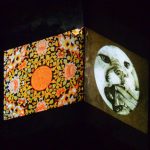Curated in collaboration with Michelle Proksell
Before the invention of film, as far back as the Paleolithic Period, humans portrayed motion in static art, such as in early Cave paintings, which traced and shaped the world they saw fit to represent. This concept of tracing gives a contemporary reflection on the early beginnings of humanity’s ability to represent motion, and the relationship of the past and present.
Hundreds of years before the advent of film production, several devices were created to depict static images in motion via forms of animation first. Early formation of the basic principles of animation, through devices such as The Magic Lantern (c. 1650), Thaumatrope (1824), Phenakistoscope (1831), Zoetrope (1834) and flip books (1868), are initially rooted in using types of printed matter, which were then put into motion through various mechanisms to illustrate and narrate visual representations.
In ancient China, a device categorised as a type of zoetrope and made of translucent paper illustrating detailed scenes, were hung over lamps, which rotated from heated air rising within them. Their horizontally drifting figures gave the effect and representation of passing time — and could be considered one of the earliest forms of moving printed matter. Considering animation, film and video’s early history was deeply connected to materials and the printed form, which were then creatively and technically adapted to produce objects and figures in motion, “MATERIAL FLUX” explores the context of contemporary printed matter from selected Chinese and International artists. These artists translate what was once static content into ideas in flux, through techniques such as stop motion and digital/analog compositing of text, poetry, collages, prints, photographs, drawings, paintings, paper cuts of various materials, including from books. Together, this compilation of footage shares a constructed world in motion—taking the printed form into a new realm of expression.
- Antonia Kuo
- Installation Photos



